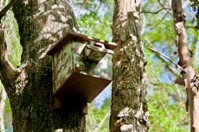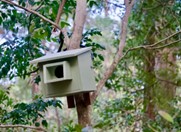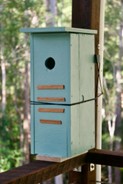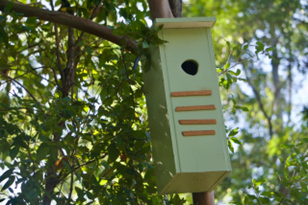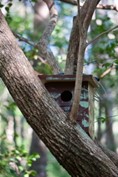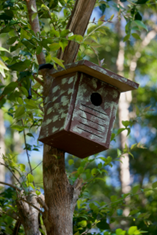Our home extends beyond the garden into a 1 1/2 acre Tall Open Forest. The forest was previously felled for timber, so there are few old trees and tree hollows. I felt that one way I could support the birds and animals was to build nesting boxes. Nesting boxes can be one way to support local species survival.
This is my first attempt at Building nesting boxes. Daunted at first, I kept avoiding starting. At the time I was not confident with power tools or working with timber. I began by accessing two resources on nesting boxes;
1. Australian Native Hollow Using Species List & Nesting Box Designs Booklet by Alice McGlashan. Website: www.nestboxtales.com
2. Nest Boxes for Wildlife – A Practical Guide (Book) by Allan and Stacey Franks. Available at the Noosa Library. Hollow Log Homes is a Noosa family business run by the Franks selling ready made nesting boxes.
Both nesting box resources were extremely helpful.
There were a number of designs of nesting boxes which were suitable for species endemic to Lake Macdonald. Initially I chose a few nesting box designs that were smaller, straight forward & easy to build. I also made sure they did not need to be placed too high in a tree.
For each box I cut out templates from cardboard using the dimensions from the book and then outlined them on the timber. I used exterior 15mm thick plywood for the sides, base and roof of each box. The plywood can be cut by hand, or using a power tool such as a circular saw or jigsaw. Your local Men’s Shed or other woodworking community organisation may also be able to assist by providing woodworking machines making cutting the timber quicker and easier. My partner kindly cut out the timber pieces for me, using a table saw, he found it was the fastest and easiest way. The sides and base of the box were joined using glue and screws and then a hinge was used to attach the roof.
Once assembled, I undercoated the outside of the boxes and then two coats of exterior outdoor paint. The next step was to wire, adding plastic tubing to the wire for hanging in the trees. I found that I had a lot of the resources in the shed, not needing to buy many of the items. i.e timber, paint, wire and plastic pipe.
I constructed six different types of nesting boxes, making eight in total (Replicating three small boxes).
1. Little Kingfisher – Entrance hole 50mm. Height placed in trees 3-6 metres.
2. Forest or Sacred Kingfisher – Entrance hole 75mm. Height placed in tree 3-6 metres.
3. Laughing Kookaburra – Entrance hole 110mm. Height Placed in tree 5-10 metres. I added a perch at the front. Currently this nesting box is at 2m height on the external electricity box. Interest from a curious Kookaburra within 2 months.

- Sugar Glider – Entrance hole 40mm. Height placed in tree 3-6 metres.
- Squirrel glider – Entrance hole 45mm. Height placed in tree 3-6 metres.
6,7 & 8. Three nesting boxes suitable for Feather tail Glider Entrance hole 30mm. Height placed in tree 2-4 m. Antechinus entrance hole 30mm. Height placed in tree 2m. Pygmy Possum entrance hole 30mm Height placed in tree 3-6m.
Parallel cuts in the timber, front of the box (under the hole) both inside and outside of the box for animal foot holds.
Initially constructing nesting box was daunting. I jumped in and made a start, made some mistakes, learnt along the way and got assistance when required. I gained lots of confidence and I ultimately enjoyed the process. I recommend giving building nesting boxes a go, it is hugely rewarding and satisfying, learning new skills and knowing you are making a difference.
Article by Leonie Stephens



